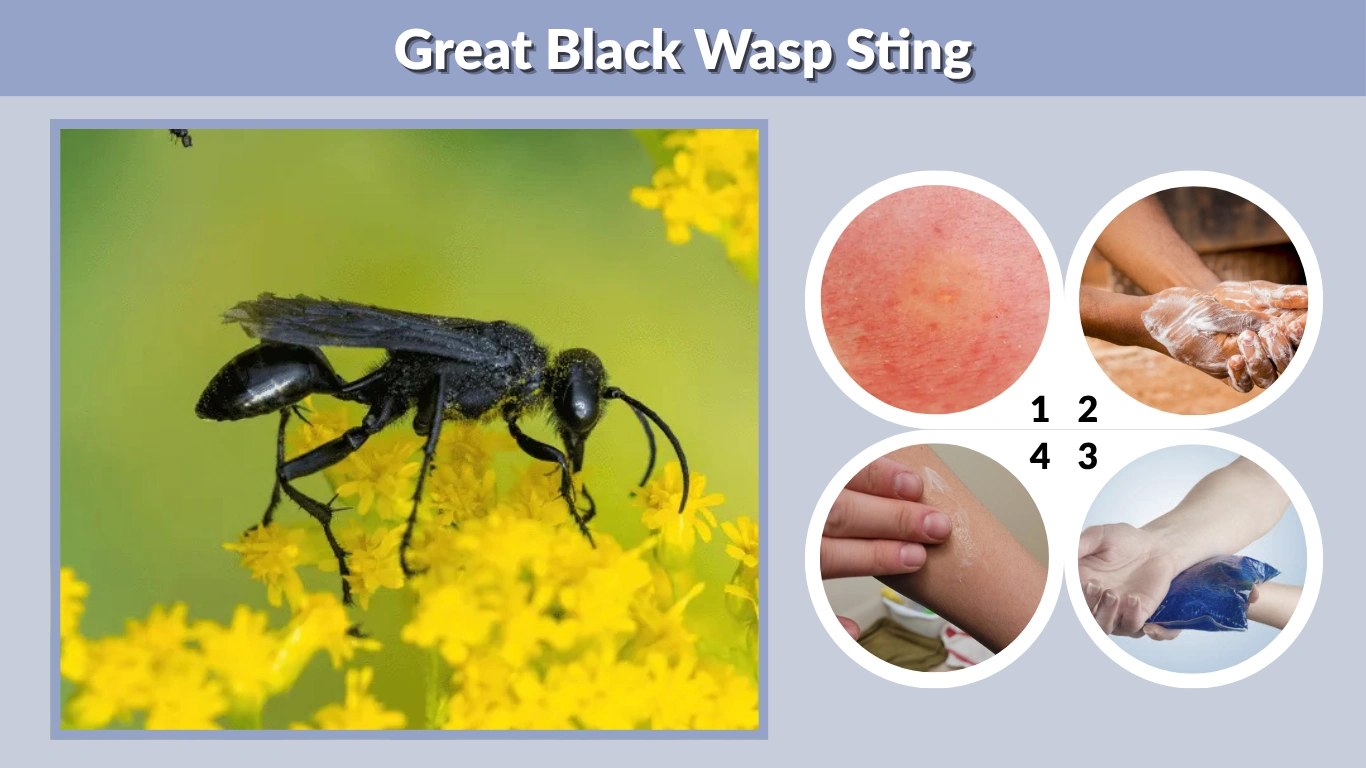The great black wasp (Sphex pensylvanicus) is a large, shiny black insect often mistaken for a hornet due to its intimidating appearance. Despite its size and sharp stinger, this wasp is generally non-aggressive and stings humans only when threatened. Understanding how painful its sting is, how to identify it, and what to do if stung helps people react calmly and correctly.
Identification
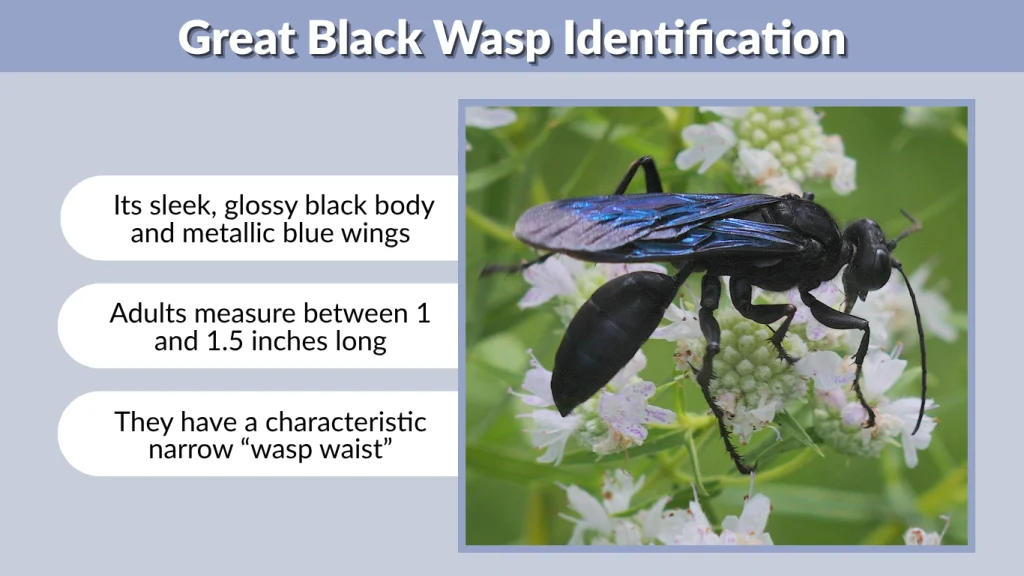
Physical Features
The great black wasp is a solitary digger wasp easily recognized by its sleek, glossy black body and metallic blue wings that glisten under sunlight. Adults measure between 1 and 1.5 inches long, making them one of the larger wasp species found in North America. They have a characteristic narrow “wasp waist” connecting the thorax and abdomen and long, thin legs adapted for digging.
Behavior
Unlike social wasps such as yellowjackets or hornets, the great black wasp lives alone. Females dig burrows in soft soil where they lay eggs and provide paralyzed insects as food for their larvae. These wasps are valuable pollinators, frequently visiting flowers for nectar. They rarely show aggression toward humans unless disturbed while nesting.
Can the Great Black Wasp Sting?
Do They Sting Humans?
Yes, female great black wasps are capable of stinging. However, they seldom use their stinger defensively. Their primary purpose for stinging is to paralyze prey like grasshoppers or katydids before placing them in underground nests as food for their developing young. Males, on the other hand, cannot sting at all.
Do They Bite or Sting?
Great black wasps sting rather than bite. Their stinger is located at the end of the abdomen and is used both for hunting and self-defense. Biting is not part of their natural behavior toward humans. The sting’s intensity depends on an individual’s sensitivity and the depth of the sting, but it is generally mild to moderate.
Great Black Wasp Sting Pain
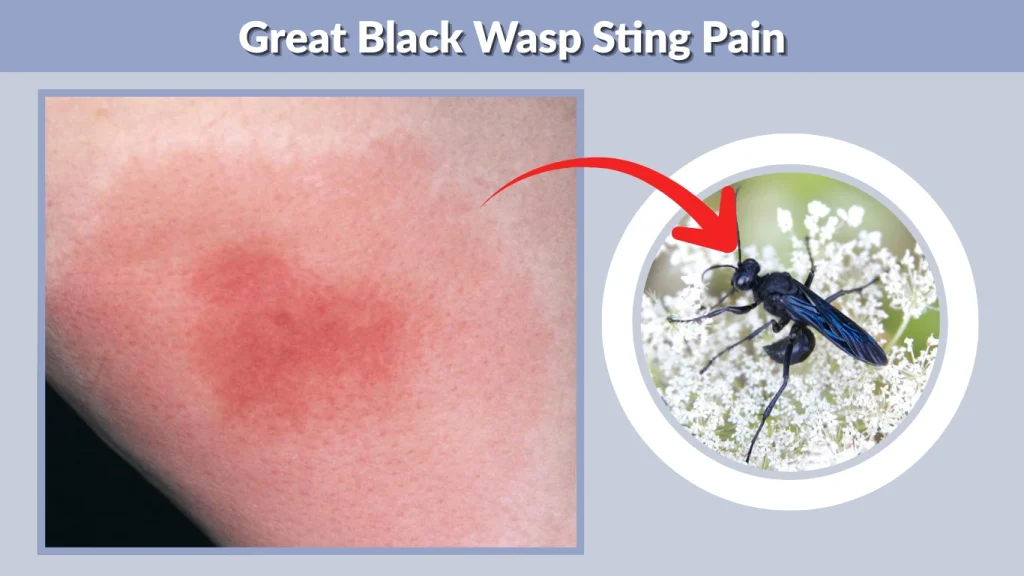
Pain Level on the Schmidt Index
Entomologist Justin O. Schmidt’s Pain Index ranks insect stings on a scale from 1 to 4. The great black wasp’s sting is rated around 1.5 to 2.0, meaning it’s more painful than a sweat bee but far less severe than a tarantula hawk or bullet ant. The pain is sharp and immediate but fades within an hour.
What It Feels Like
Most victims describe the sensation as a brief, burning sting followed by a dull ache. The pain typically lasts from a few minutes to an hour, with redness or swelling that subsides after a day. People allergic to insect venom may experience stronger reactions, including prolonged pain or itching.
Reaction and Symptoms
Typical Sting Reaction
In most cases, a great black wasp sting causes localized swelling, redness, and mild pain. The skin around the sting site may feel warm or itchy. These symptoms usually fade within a day or two. Applying cold compresses and topical creams often provides quick relief.
Severe Allergic Responses
Though uncommon, individuals allergic to wasp venom may develop more serious symptoms such as hives, difficulty breathing, dizziness, or swelling of the face and throat. These signs indicate an anaphylactic reaction and require immediate medical treatment.
Treatment and Relief
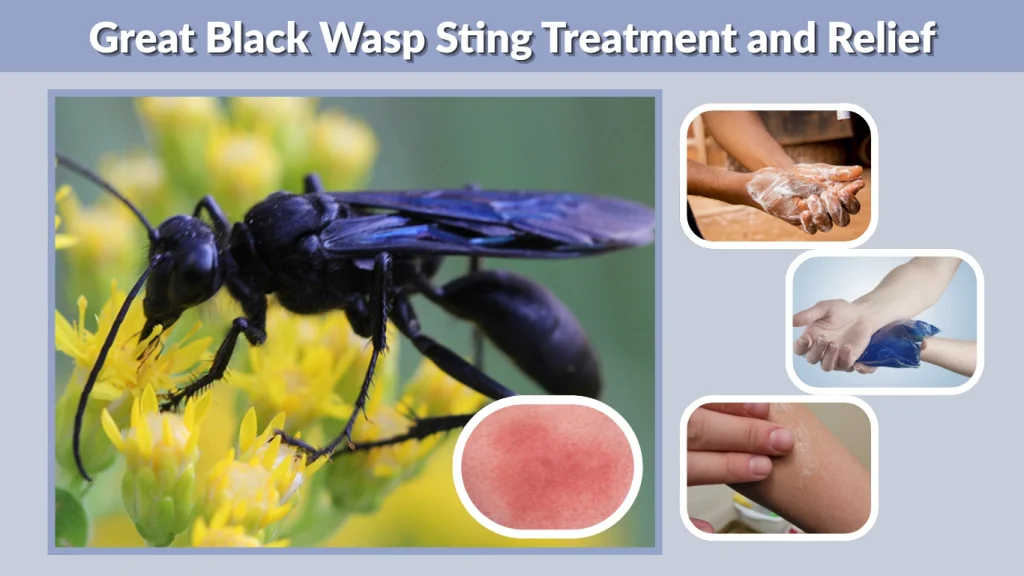
Immediate First Aid
If stung by a great black wasp, stay calm and act quickly. Wash the area with soap and water to remove any venom residue. Applying an ice pack or cold compress helps reduce swelling and pain. Over-the-counter antihistamines or hydrocortisone creams can relieve itching and redness.
Home Remedies
Some natural remedies also help soothe the affected area. Applying baking soda paste, aloe vera gel, or apple cider vinegar can ease pain and reduce inflammation. Keeping the area clean and avoiding scratching prevents infection.
Stinger Details
Do They Leave a Stinger?
Unlike honeybees, great black wasps do not leave their stinger behind after stinging. Their stinger is smooth, flexible, and retractable, allowing them to sting multiple times without harm to themselves. This feature helps them repeatedly paralyze prey like grasshoppers or katydids for nesting.
Stinger Size
The female great black wasp’s stinger measures about 3 to 4 millimeters in length. Though relatively small, it is strong and precise, designed for injecting venom efficiently. The stinger also doubles as an ovipositor, used to lay eggs in prey insects that have been paralyzed but remain alive for the larvae to feed on.
Purpose of the Sting
For humans, the sting is a defensive act, but for the wasp, it’s a survival tool. The venom doesn’t kill prey but paralyzes them, ensuring a fresh food source for their offspring. This biological purpose makes the great black wasp more of a hunter than a fighter.
What Does a Great Black Wasp Sting Look Like?
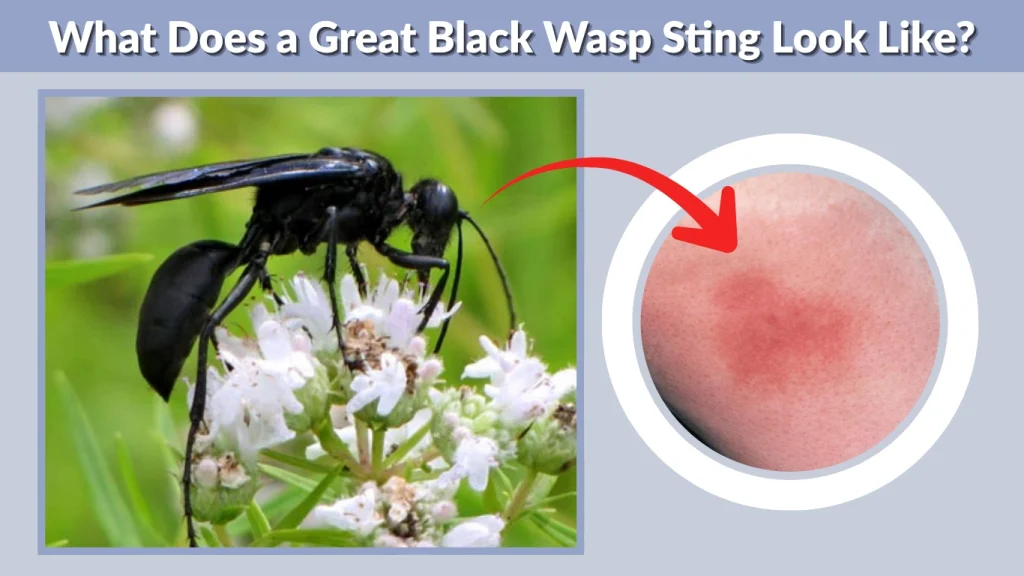
A sting from a great black wasp usually appears as a small, red bump or welt, similar to a mosquito bite but slightly more pronounced. Swelling can occur, especially if the sting is on softer skin like the arm or neck. The area might feel warm and tender for several hours. In sensitive individuals, a light rash or hives may appear, but these symptoms typically resolve on their own within 24–48 hours.
If multiple stings occur, or if the person experiences dizziness, nausea, or swelling of the face or throat, it’s important to seek medical attention immediately, as these can signal an allergic reaction.
Great Black Wasp Behavior Around Humans
Despite their size and ability to sting, great black wasps are non-aggressive pollinators. They play a vital role in maintaining garden ecosystems by feeding on nectar and controlling pest populations. Females spend most of their time hunting insects to feed their larvae, rarely interacting with humans. Observing these wasps from a distance is safe and even beneficial to gardens.
People sometimes mistake their hovering or circling behavior for aggression. In reality, they are simply searching for nesting sites or inspecting potential prey. They only sting when directly threatened or accidentally handled.
Preventing Stings
To avoid stings, do not disturb their nests or attempt to swat them. If you encounter one, stay calm and move slowly away. Wearing light-colored clothing while gardening or working outdoors can make you less noticeable to wasps.
If you discover a nesting area close to human activity, consider contacting a pest management professional to relocate them safely without harming these valuable insects.
FAQs
What does a great black wasp sting look like?
A great black wasp sting typically leaves a red, raised bump or welt with mild swelling. It may feel warm, sore, or itchy for several hours but usually heals within one or two days without lasting marks or scarring.
How painful is a great black wasp sting?
The pain is moderate—sharp and burning at first, then dull and throbbing. It’s ranked around 1.5 to 2.0 on the Schmidt Pain Index, meaning it’s uncomfortable but short-lived and far less severe than stings from hornets or tarantula hawks.
How do you treat a great black wasp sting?
Immediately wash the area with soap and water, then apply a cold compress for 10–15 minutes. Hydrocortisone cream or antihistamines can reduce swelling and itching. Avoid scratching, and if symptoms worsen or an allergic reaction occurs, seek medical help right away.
Do great black wasps die after stinging?
No, great black wasps do not die after stinging. Their stinger is smooth and retractable, allowing multiple stings without self-injury. Unlike honeybees, which lose their stingers, great black wasps can sting repeatedly if provoked.
Can a great black wasp sting kill a spider?
Yes. Female great black wasps use their sting to paralyze, not kill, spiders or katydids. They drag the immobilized prey into their burrows to serve as a live food source for their larvae. The venom ensures the prey stays fresh until the larvae finish feeding.

